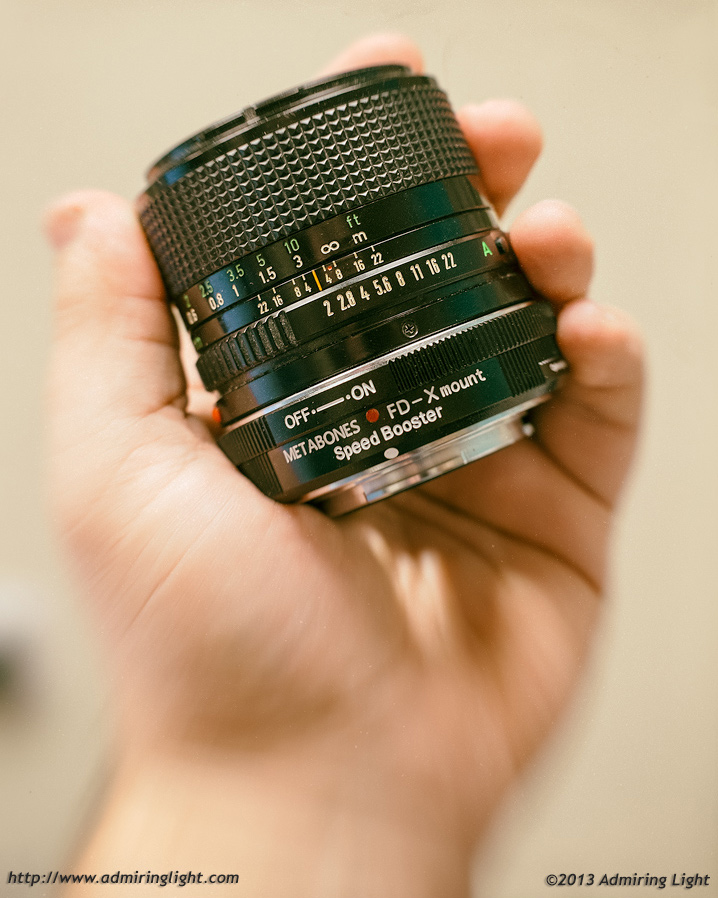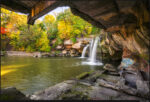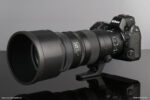Image Quality
First off, let’s get the big question out of the way first: Is it worth paying $400 for a Speed Booster when you can get a Lens Turbo for only $130? As one who has both adapters, in my opinion, absolutely. If you are in the market for one of these wide converters, save up and get the Metabones. When used with faster lenses, the Speed Booster is significantly sharper on the edges of the frame, and frankly anywhere outside the center 20% of the frame. Field curvature also doesn’t seem to be nearly as big a problem as it is with the Lens Turbo.
So now let’s get on to specifics with the Speed Booster.
Sharpness

Metabones promises increased MTF on lenses when used with the Speed Booster. This turns out to be both true and false. In the central part of the image, this claim is certainly true, with images being surprisingly sharp in the center, and indeed sharper than the bare lens with a standard adapter. Towards the edges, it’s not quite as true, as there is some softening of detail and contrast as you get to the edges of the frame. Luckily, with the Speed Booster, this softening isn’t particularly severe. Images from the fast lenses I tested are usable across the vast majority of the frame even wide open. There is some variation on performance based on a specific lens, however.
I tried the Speed Booster on the Canon new FD 50mm f/1.4, the Canon FD 50mm f/1.4 SSC and the Canon FL 55mm f/1.2. All of these lenses are fast normal focal length lenses, and all three are quite sharp across the frame by themselves. While the two 50mm lenses performed near identically, the FL 55mm f/1.2 performs notably better across the frame. While there is a visible dip in resolution on the 50mm lenses about a quarter of the way into the frame from the long edge, the 55mm retains good sharpness until you get to the corners. This is not to say the 50mm lenses performed poorly. They are still quite decent, but that sharpness dropoff is visible if you pixel peep. I also noticed edge resolution loss on the FD 35mm f/2 and 85mm f/1.8, though the FD 135mm f/2, like the 55mm f/1.2, seemed largely immune to this.
One thing that is consistent with all lenses, though, is that the sharpness profile is slightly wavy…very sharp in the center, then going a little softer as you near the edges, then sharpness increases again as you get to the very edge of the frame. The extreme corners, however, go to complete mush with all lenses. Luckily, this is only the last 2-3% of the corner and is almost never an issue unless you are using the Speed Booster for critical landscape work stopped down on a tripod.
Using these lenses stopped down to optimal aperture yields sharp images across the frame (excepting the extreme corners). While you still may notice some of that wavy sharpness profile if you look very closely with some lenses, overall, the lenses perform very well stopped down.
On the whole I was very impressed with the sharpness that the Speed Booster was able to maintain. Even those that don’t work quite as well are still quite usable. Compared to the Lens Turbo, it’s not even a contest: The Speed Booster is much better with faster aperture lenses.

Bokeh
Thankfully, the Speed Booster appears to have no major effect on the bokeh characteristics of a lens. At least, no detrimental effect. It’s hard to say if it affects the edge bokeh, as I can’t mount FD lenses to a modern full frame DSLR to test this. If I get my hands on a Sony A7 for review, I’ll try to test this to see how full frame corner bokeh looks with and without the Speed Booster.
In any case, bokeh from the lenses appears to be well in line with the lens’ native look. As one of the main reasons for getting the Speed Booster is to obtain full-frame shallow depth of field capability on an APS-C camera, this is very good news.
Lens Aberrations
In contrast with the Lens Turbo, the Speed Booster did not seem to have any major effect on chromatic aberration. There may be a very slight increase in lateral CA, but for all intents and purposes, it’s nothing to worry about.
There is a notable increase in barrel distortion with certain lenses, especially at close focus distances. This is lens dependent, however, and seemed more dependent on focal length than anything else. Wider and normal lenses showed more distortion, while longer lenses showed virtually none.
Additionally, partly because of the use of the full image circle and partly because of the limited optical size of the Speed Booster, there is visible corner shading or vignetting with the Speed Booster. For portrait considerations, I actually view this as a positive, as I quite like some natural lens vignetting or shading in my portraits. It is flattering to the subject and the photo in most situations. In other situations, it’s not so good. I found that I could correct natural lens vignetting via the vignetting slider in Lightroom, though sometimes it took maxing out the slider to correct it. However, caution must be taken when shooting with telephoto lenses with deeply recessed rear elements with the Speed Booster. These lenses can actually mechanically vignette, causing a hard black edge to the corners that can’t really be corrected. Of all my FD glass, only my FD 50-300mm f/4.5L suffered from this, but it was visible at all focal lengths.

One important thing to note is the Speed Booster does not seem to generally affect how a lens draws. If you like a certain lens for the way it handles tonal transitions, or depth of field rolloff, or the contrast of the lens, these things are all preserved with the Speed Booster.
Pixel Shading
Note: This is not a flaw with the Speed Booster, but rather a limitation of digital cameras as they currently exist. It is important to note that the ‘extra stop of light’ you get with the Speed Booster breaks down when you start dealing with extremely fast lenses. While the optical effect is always there, the exposure benefit hits a wall around f/1.1 due to an effect called Pixel Shading.
What this means is that due to the depth of the microlenses and pixel wells in the sensor, there is only so much light that can be gathered by the lens and transmitted to these wells. The limit comes around f/1.1 or so. You can see this in the f/0.95 lenses for Micro 4/3: While they certainly exhibit shallower depth of field and the blurrier backgrounds associated with its f/0.95 aperture, it only exposes about a half a stop faster than an f/1.4 lens.
Similarly, using an f/1.2 lens on the speed booster results in a combination with an insane aperture of f/0.9! It would nominally be an f/0.85 lens, though the Speed Booster is limited to f/0.9 due to the size of the optics. Again, the optical considerations and rendering are fully consistent with this f/0.9 aperture, but you’ll notice that the shutter speed you get with the lens at f/0.9 is only fractionally faster than what you get with the lens without the Speed Booster. Since I am mostly after the optical characteristics, this is not a big deal, but it is worth noting that you will hit a wall with the Speed Booster in terms of exposure when you start dealing with ultra-fast lenses.






Leave a Reply